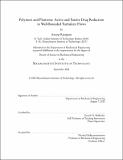| dc.contributor.advisor | Gareth H. McKinley. | en_US |
| dc.contributor.author | Rajappan, Anoop. | en_US |
| dc.contributor.other | Massachusetts Institute of Technology. Department of Mechanical Engineering. | en_US |
| dc.date.accessioned | 2021-06-17T17:21:18Z | |
| dc.date.available | 2021-06-17T17:21:18Z | |
| dc.date.copyright | 2020 | en_US |
| dc.date.issued | 2020 | en_US |
| dc.identifier.uri | https://hdl.handle.net/1721.1/131007 | |
| dc.description | Thesis: Sc. D., Massachusetts Institute of Technology, Department of Mechanical Engineering, September, 2020 | en_US |
| dc.description | Cataloged from the official PDF version of thesis. | en_US |
| dc.description | Includes bibliographical references (pages 187-211). | en_US |
| dc.description.abstract | Frictional energy dissipation in wall-bounded turbulence is ubiquitous in modern engineering systems, ranging from the flow of liquids through pipelines, to the drag-inducing boundary layer around ships and submarines. The effective mitigation of this frictional drag is therefore of great practical interest, and offers substantial economic and environmental benefits. This thesis focuses on two complementary techniques for turbulent drag reduction--the active injection of polymers into the flow, and the passive aerophilic texturing of the wall--and aims to address practical challenges that prevent their widespread adoption in real-life systems, with an emphasis on marine applications. The prohibitive cost of synthetic polymers remains a key impediment to their large-scale deployment in commercial marine operations. | en_US |
| dc.description.abstract | This thesis hence focuses on affordable and readily accessible sources of high molecular weight biopolymers: specifically, the water-soluble fiber, or mucilage, extracted from seeds such as flax, chia and psyllium. By means of frictional drag measurements inside a bespoke Taylor-Couette apparatus, seed mucilage is shown herein to display drag reduction efficacy and flow longevity comparable to common synthetic polymers, while offering significant advantages in terms of raw material cost and biodegradability. Preliminary investigations confirm that oil-soluble natural polymers, such as rubber latex, can analogously be employed as eco-friendly drag reducers for the transport of hydrocarbon feedstocks. Superhydrophobic texturing of submerged flow boundaries has emerged recently as another viable method of drag reduction in aqueous flows. | en_US |
| dc.description.abstract | Despite sustained research interest in both polymers and superhydrophobic walls as standalone methods for drag mitigation, attempts to employ them jointly has remained unsuccessful. In this thesis, cooperative drag reduction effects are explored for two common drag-reducing polymers, paired with regularly patterned as well as randomly textured superhydrophobic walls. Dissolved flexible macromolecules are shown to act in concert with the slip-inducing air layer, or plastron, trapped atop the superhydrophobic texture, yielding enhanced reductions in turbulent drag greater than that achievable from either method employed independently. An additive law in Prandtl-von Kármán coordinates is derived that accurately predicts this combined effect at dilute polymer concentrations, and the adverse influence of the surface activity of polymers on wall slip is also elucidated. | en_US |
| dc.description.statementofresponsibility | by Anoop Rajappan. | en_US |
| dc.format.extent | 211 pages | en_US |
| dc.language.iso | eng | en_US |
| dc.publisher | Massachusetts Institute of Technology | en_US |
| dc.rights | MIT theses may be protected by copyright. Please reuse MIT thesis content according to the MIT Libraries Permissions Policy, which is available through the URL provided. | en_US |
| dc.rights.uri | http://dspace.mit.edu/handle/1721.1/7582 | en_US |
| dc.subject | Mechanical Engineering. | en_US |
| dc.title | Polymers and plastrons : active and passive drag reduction in wall-bounded turbulent flows | en_US |
| dc.title.alternative | Active and passive drag reduction in wall-bounded turbulent flows | en_US |
| dc.type | Thesis | en_US |
| dc.description.degree | Sc. D. | en_US |
| dc.contributor.department | Massachusetts Institute of Technology. Department of Mechanical Engineering | en_US |
| dc.identifier.oclc | 1256660148 | en_US |
| dc.description.collection | Sc.D. Massachusetts Institute of Technology, Department of Mechanical Engineering | en_US |
| dspace.imported | 2021-06-17T17:21:18Z | en_US |
| mit.thesis.degree | Doctoral | en_US |
| mit.thesis.department | MechE | en_US |
